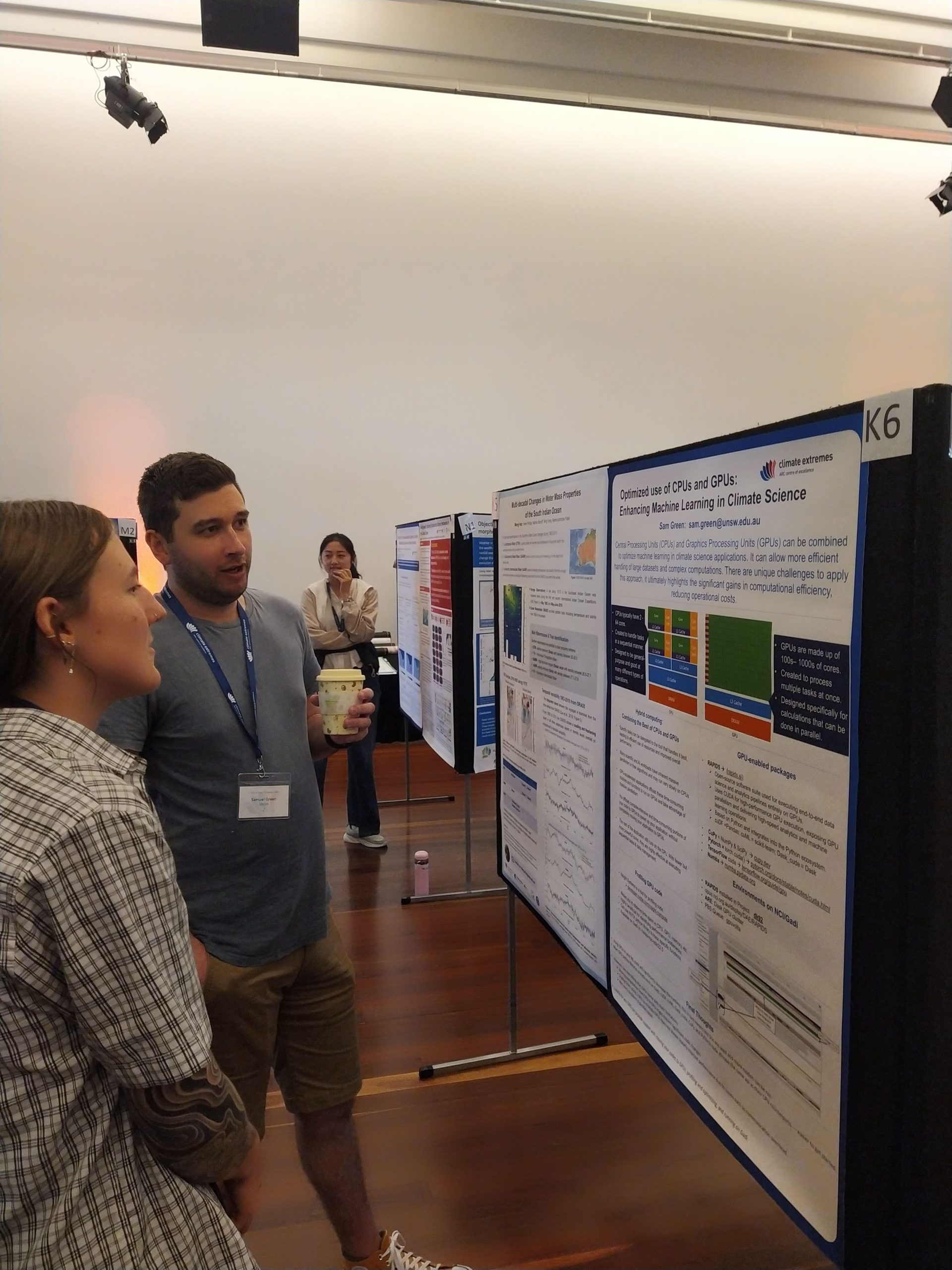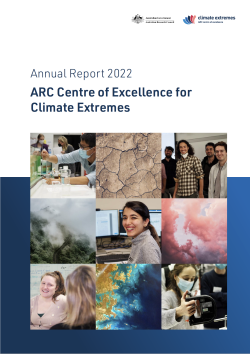The Computational Modelling Systems team provides technical support with climate model configuration, data analysis, and data management to researchers at the ARC Centre of Excellence for Climate Extremes. The team provides support via a helpdesk and runs a weekly CodeBreak online session. The CodeBreak includes short training sessions on various topics and allows the team to work one-on-one with the researchers, solving their coding issues. Blog posts, training, and other documentation are other ways the team supports the community. These are important for answering frequently asked questions efficiently and quickly.
Highlights in 2023 include work on high-resolution atmospheric simulations using the Australian Community Climate and Earth System Simulator (ACCESS) atmosphere-land coupled model. This work generated several simulations of extreme weather events, the output of which is now available to the Centre researchers and students for analysis. The data will be published in the next few months using a new version of the ACCESS post-processor tool, on which the team has also been working in the last few months.
Another important project was integrating a groundwater module in the Community Atmosphere Biosphere Land Exchange (CABLE) model. This is now completed and ready to become part of the official CABLE version. These projects are part of our collaboration with the ACCESS National Research Infrastructure (ACCESS-NRI).
Finally, the team continues working on several data projects and collaborations to improve resources to manage and access climate data sets. Our focus for the coming
year will be to ensure that all our training, data and code work developed across several years will be properly documented and, where possible, maintained past the Centre’s lifespan.

HIGHLIGHTS
Modelling extreme weather events in Australia at 2.2km resolution
Last year, the Weather and Climate Interactions research program prepared a high-resolution regional atmosphere simulation of Australia and the surrounding ocean to enable modelling of extreme weather in unprecedented detail. Dale Roberts’ major optimisation efforts made it practical to run this AUS2200 model configuration over longer time periods, with the speed of the modelling workflow being improved by a factor of 10, from three model days per day to over 30.
Whilst the running time improved, there was still the challenge of procuring enough computing time allocation to perform the simulations. In March we learned about the STRESS2023 initiative at the NCI. This is an allocation to run large-scale workflows on the new Sapphire Rapids nodes, just recently added to the Gadi NCI server. This gave Dale
a chance to put in an application to participate using the future simulations planned for AUS2200 as a use case. We were granted 10 MSU worth of computer time. To put it in perspective: This is nearly double what the entire Centre of Excellence gets allocated every quarter of the year.
A list of simulations covering extreme weather events was agreed with the Weather and Climate Interactions program group. These included a series of bushfires, the 2022 northern NSW floods, an extreme East Coast Low event and a complete Madden-Julian Oscillation cycle under El Niño, La Niña, and Neutral phases.
The resulting data will lead to a deeper understanding of extreme weather phenomena over Australia, including a more rigorous evaluation of the scientific accuracy of the AUS2200 model than previously possible. These model simulations also tested the performance and behaviour of the Unified Model on the new Sapphire Rapids nodes, with a final modelling speed of 54.5 days in 24 hours. This provided insight on the effective use of NCI facilities for Unified Model users with immediate implications for the Bureau, CSIRO and Centre climate researchers.
Generating user-friendly ACCESS model output
Paola Petrelli and Sam Green created a new ACCESS Model Output Post-Processor (MOPPeR), a Python-based tool designed to convert the ACCESS model output to a Climate Model Intercomparison Project 6 (CMIP6)-compliant format. It produces data which is easier to use and well documented, as well as performing calculations for derived variables.
ACCESS-MOPPeR started as an upgrade of the APP4, which was used to process model output for CMIP6 experiments. This was a powerful tool but it was built for specific ACCESS configurations. The new tool can be customised more easily to work for different model configurations. The first published version was, in fact, used to produce output for the AUS2200 simulations.
All ACCESS-MOPPeR package dependencies have been upgraded, which resulted in a faster, more reliable code. The mapping between raw model output and compliant output is now much more flexible and automated. The tool can also be customised to produce output conformant to different standards — including, but not limited to, CMIP6 and potentially CMIP7. An important design feature is that the mapping functionality can be used independently of the file processing; so potentially to aid separate tasks, like data cataloguing.
The tool is hosted in the ACCESS-NRI Github organisation. Throughout the development phase we have kept in touch with key people in the NRI, so as to facilitate its use across the ACCESS community.
CABLE groundwater module integration
Ramzi Kutteh completed the integration of the groundwater component of CABLE developed by Dr Mengyuan Mu four years ago. During this time the CABLE code went through a significant refactoring, and for this reason the integration was structured in two phases.
The first involved implementing Dr Mu’s work into a version of CABLE just preceding refactoring of the code. The first phase, including extensive testing, corrections and validation by Dr Mu, was successfully completed around May 2023. In addition, a set of notes, tables and diagrams detailing the changes made in the first-phase code was prepared for future reference.
The second phase of the project involved integration of the code resulting from the first phase into the current (as of June 2023) CABLE version. The coding aspect of this second phase was completed in early September 2023, followed by successful testing and debugging. As with the first, this phase is also accompanied by extensive documentation. Some of this has contributed to the important project of improving the CABLE documentation, led by Dr Claire Carouge from ACCESS-NRI.

ARC Centre of Excellence for Climate Extremes – Annual Report 2023
From the Chair of the Advisory Board
Climate Science Leaders of the Future
Weather and Climate Interactions Research Program
Attribution and Risk Research Program
Ocean Extremes Research Program
Computational Modelling Systems
Governance, Management and our Commitment to Equity, Diversity and Inclusion

